Do you have a question about the Crown DriveCore I-Tech 4x3500 HD and is the answer not in the manual?
Instructions for obtaining the manual in different languages.
List of trademarks and their owners.
Key safety symbols, cautions, and magnetic field warnings.
Highlights of the amplifier's key features and capabilities.
Guidance on navigating and utilizing the operation manual effectively.
Instructions for unboxing, inspecting, and physically installing the amplifier.
Steps for safely connecting the amplifier to the AC power supply.
Guidelines for connecting audio input and output cables.
Guidance on selecting appropriate wires and connectors for audio inputs.
Guidance on selecting appropriate wires and connectors for speaker outputs.
Specific wiring instructions for stereo amplifier operation.
Instructions for configuring and wiring the amplifier in bridge-mono mode.
Overview of HARMAN's commitment to environmental responsibility.
Discusses the efficiency benefits of the amplifier's design.
Provides examples of energy and cost savings associated with GreenEdge.
Strategies and settings to prevent damage to connected loudspeakers.
Steps to follow when initially powering on the amplifier.
Important precautions to ensure optimal performance and safety.
Explanation of the amplifier's front panel buttons, knobs, and LEDs.
Explanation of the amplifier's rear panel connections and indicators.
Introduction to advanced features accessible via the LCD control screen.
Explanation of how to navigate the amplifier's menu structure using the LCD.
Practical examples demonstrating operations using the LCD screen.
Description of basic screen displays and interactions on the LCD.
How to set and manage the amplifier's DSP sample rate.
Adjusting analog input sensitivity and understanding gain settings.
Overview of presets, their function, and recall procedures.
How to select between Dual, Input Y, and Bridge Mono amplifier modes.
Using the locate feature to identify specific amplifiers in a network.
Configuring attenuator limits, links, input sources, and max analog input.
Adjusting AES digital input gain and source priority settings.
Checking AES input lock status and adjusting CobraNet input gain.
Configuring bandpass gain, output polarity, input, and output delay.
Setting LED meter types and configuring clip/RMS voltage limiters.
Configuring peak voltage limiter and enabling front panel blackout mode.
Using the pink noise generator and configuring screen settings.
Monitoring amplifier status including load, thermal, AC voltage, and operating time.
Monitoring speaker load status and amplifier temperature readings.
Displaying AC line voltage and total amplifier operating hours.
Reporting and clearing amplifier, signal, or load errors.
Viewing and clearing errors related to amplifier output clipping events.
Monitoring and clearing load impedance and line voltage errors.
Checking for sweep load monitoring errors and fan errors.
Function to clear all logged error messages from the amplifier.
Setting up audio network parameters like IP and HiQnet addresses.
Viewing network status (IP, MAC) and amplifier manufacturing details.
Setting the HiQnet address and configuring DHCP for network addressing.
Configuring the subnet mask for network addressing.
Configuring CobraNet network parameters.
Viewing CobraNet firmware and status, and setting transport latency.
Configuring CobraNet transmit bundles and receive channels.
Setting the priority for the CobraNet conductor device.
Managing, saving, and recalling amplifier presets.
Introduction to presets, their types, and manual configuration.
Creating, saving, and downloading custom or manufacturer-provided presets.
Using the USB port for transferring preset, device, and firmware files.
Explanations of messages and pop-up boxes that may appear on the LCD screen.
Using AES3 and VDrive for digital audio input and transmission.
Guidance on connecting the amplifier to an existing network.
Overview of the amplifier's DSP capabilities and software control.
Interface for selecting and controlling DSP functions per channel.
How to configure the amplifier's operational mode (e.g., stereo, bridge).
Explanation of front panel input/output level meters and status indicators.
Selecting and configuring audio signal sources for each amplifier channel.
Setting levels, muting, and sensitivity for analog, AES, and CobraNet inputs.
Advanced configuration options for CobraNet network parameters.
Using the input compressor to control dynamic range per channel.
Setting signal delay for inputs and driver/output timing.
Adjusting equalization settings for input and output signals.
Configuring IIR and FIR filters for loudspeaker crossovers.
Overview of LevelMax limiter modes and key limiter types.
Explanation of LevelMax limiter modes (Auto, Advanced) and types.
Configuring front panel display security and USB port lockout.
Configuring amplifier output, error reporting, and standby modes.
Enabling and configuring the load supervision feature for real-time monitoring.
Accessing and viewing amplifier model, serial number, and firmware details.
Applying current amplifier settings to other devices in the system.
Information on inherent DSP processing delay and latency figures.
Managing, saving, and recalling amplifier presets.
Using the built-in signal generator for noise and sine wave testing.
Configuring the amplifier for fixed-gain operation for consistent gain.
Diagnosing and resolving issues related to power indicators and thermal warnings.
Diagnosing and resolving issues related to fault indicators and signal presence.
Diagnosing and resolving issues related to no sound output and network connectivity.
Table detailing power output specifications under various load conditions.
Key performance metrics including sensitivity, gain, and distortion.
Information on the amplifier's build, ventilation, cooling, and physical dimensions.
Details on the amplifier's comprehensive protection and diagnostic systems.
Features of the universal power supply and its PFC benefits.
Explanation of the Class I circuitry and its advantages.
Description of the color-coding system on the rear panel for identification.
Introduction to HiQnet protocol for controlling and monitoring audio devices.
Explanation of MAC addresses, IP addresses, and the network discovery process.
Overview of the CobraNet protocol for digital audio transmission.
Details on Fast Ethernet networking and CobraNet's audio specifications.
How audio channels are grouped into bundles for CobraNet transmission.
Role of the conductor in coordinating CobraNet digital audio traffic.
Explanation of how switched networks enhance CobraNet performance.
Explanation of LevelMAX peak limiting, threshold, attack, release, and look-ahead.
Explanation of LevelMAX RMS limiting, threshold, and calculation methods.
Explanation of LevelMAX thermal limiting and response time settings.
Introduction to FIR filters and comparison with IIR filters.
Discusses desirable attributes of FIR filters like linear phase and steep slopes.
Addressing polar lobing error and Crown's specific FIR filter techniques.
Explanation of the Fast Fourier Transform convolution technique used in FIR filters.
FIR filter design principles and computational requirements.
Demonstrating FIR crossover benefits through real-world measurements.
Measurement results of a standard IIR crossover filter.
Measurement results of an FIR crossover filter.
Final FIR measurement results and summary of advantages.
List of references for further reading on digital signal processing.
Procedures for obtaining service outside the US.
Details on obtaining service through US service centers or the factory.
Overview of the warranty terms, coverage, and exclusions.
Procedures for claiming warranty service and legal disclaimers.
Instructions for obtaining the manual in different languages.
List of trademarks and their owners.
Key safety symbols, cautions, and magnetic field warnings.
Highlights of the amplifier's key features and capabilities.
Guidance on navigating and utilizing the operation manual effectively.
Instructions for unboxing, inspecting, and physically installing the amplifier.
Steps for safely connecting the amplifier to the AC power supply.
Guidelines for connecting audio input and output cables.
Guidance on selecting appropriate wires and connectors for audio inputs.
Guidance on selecting appropriate wires and connectors for speaker outputs.
Specific wiring instructions for stereo amplifier operation.
Instructions for configuring and wiring the amplifier in bridge-mono mode.
Overview of HARMAN's commitment to environmental responsibility.
Discusses the efficiency benefits of the amplifier's design.
Provides examples of energy and cost savings associated with GreenEdge.
Strategies and settings to prevent damage to connected loudspeakers.
Steps to follow when initially powering on the amplifier.
Important precautions to ensure optimal performance and safety.
Explanation of the amplifier's front panel buttons, knobs, and LEDs.
Explanation of the amplifier's rear panel connections and indicators.
Introduction to advanced features accessible via the LCD control screen.
Explanation of how to navigate the amplifier's menu structure using the LCD.
Practical examples demonstrating operations using the LCD screen.
Description of basic screen displays and interactions on the LCD.
How to set and manage the amplifier's DSP sample rate.
Adjusting analog input sensitivity and understanding gain settings.
Overview of presets, their function, and recall procedures.
How to select between Dual, Input Y, and Bridge Mono amplifier modes.
Using the locate feature to identify specific amplifiers in a network.
Configuring attenuator limits, links, input sources, and max analog input.
Adjusting AES digital input gain and source priority settings.
Checking AES input lock status and adjusting CobraNet input gain.
Configuring bandpass gain, output polarity, input, and output delay.
Setting LED meter types and configuring clip/RMS voltage limiters.
Configuring peak voltage limiter and enabling front panel blackout mode.
Using the pink noise generator and configuring screen settings.
Monitoring amplifier status including load, thermal, AC voltage, and operating time.
Monitoring speaker load status and amplifier temperature readings.
Displaying AC line voltage and total amplifier operating hours.
Reporting and clearing amplifier, signal, or load errors.
Viewing and clearing errors related to amplifier output clipping events.
Monitoring and clearing load impedance and line voltage errors.
Checking for sweep load monitoring errors and fan errors.
Function to clear all logged error messages from the amplifier.
Setting up audio network parameters like IP and HiQnet addresses.
Viewing network status (IP, MAC) and amplifier manufacturing details.
Setting the HiQnet address and configuring DHCP for network addressing.
Configuring the subnet mask for network addressing.
Configuring CobraNet network parameters.
Viewing CobraNet firmware and status, and setting transport latency.
Configuring CobraNet transmit bundles and receive channels.
Setting the priority for the CobraNet conductor device.
Managing, saving, and recalling amplifier presets.
Introduction to presets, their types, and manual configuration.
Creating, saving, and downloading custom or manufacturer-provided presets.
Using the USB port for transferring preset, device, and firmware files.
Explanations of messages and pop-up boxes that may appear on the LCD screen.
Using AES3 and VDrive for digital audio input and transmission.
Guidance on connecting the amplifier to an existing network.
Overview of the amplifier's DSP capabilities and software control.
Interface for selecting and controlling DSP functions per channel.
How to configure the amplifier's operational mode (e.g., stereo, bridge).
Explanation of front panel input/output level meters and status indicators.
Selecting and configuring audio signal sources for each amplifier channel.
Setting levels, muting, and sensitivity for analog, AES, and CobraNet inputs.
Advanced configuration options for CobraNet network parameters.
Using the input compressor to control dynamic range per channel.
Setting signal delay for inputs and driver/output timing.
Adjusting equalization settings for input and output signals.
Configuring IIR and FIR filters for loudspeaker crossovers.
Overview of LevelMax limiter modes and key limiter types.
Explanation of LevelMax limiter modes (Auto, Advanced) and types.
Configuring front panel display security and USB port lockout.
Configuring amplifier output, error reporting, and standby modes.
Enabling and configuring the load supervision feature for real-time monitoring.
Accessing and viewing amplifier model, serial number, and firmware details.
Applying current amplifier settings to other devices in the system.
Information on inherent DSP processing delay and latency figures.
Managing, saving, and recalling amplifier presets.
Using the built-in signal generator for noise and sine wave testing.
Configuring the amplifier for fixed-gain operation for consistent gain.
Diagnosing and resolving issues related to power indicators and thermal warnings.
Diagnosing and resolving issues related to fault indicators and signal presence.
Diagnosing and resolving issues related to no sound output and network connectivity.
Table detailing power output specifications under various load conditions.
Key performance metrics including sensitivity, gain, and distortion.
Information on the amplifier's build, ventilation, cooling, and physical dimensions.
Details on the amplifier's comprehensive protection and diagnostic systems.
Features of the universal power supply and its PFC benefits.
Explanation of the Class I circuitry and its advantages.
Description of the color-coding system on the rear panel for identification.
Introduction to HiQnet protocol for controlling and monitoring audio devices.
Explanation of MAC addresses, IP addresses, and the network discovery process.
Overview of the CobraNet protocol for digital audio transmission.
Details on Fast Ethernet networking and CobraNet's audio specifications.
How audio channels are grouped into bundles for CobraNet transmission.
Role of the conductor in coordinating CobraNet digital audio traffic.
Explanation of how switched networks enhance CobraNet performance.
Explanation of LevelMAX peak limiting, threshold, attack, release, and look-ahead.
Explanation of LevelMAX RMS limiting, threshold, and calculation methods.
Explanation of LevelMAX thermal limiting and response time settings.
Introduction to FIR filters and comparison with IIR filters.
Discusses desirable attributes of FIR filters like linear phase and steep slopes.
Addressing polar lobing error and Crown's specific FIR filter techniques.
Explanation of the Fast Fourier Transform convolution technique used in FIR filters.
FIR filter design principles and computational requirements.
Demonstrating FIR crossover benefits through real-world measurements.
Measurement results of a standard IIR crossover filter.
Measurement results of an FIR crossover filter.
Final FIR measurement results and summary of advantages.
List of references for further reading on digital signal processing.
Procedures for obtaining service outside the US.
Details on obtaining service through US service centers or the factory.
Overview of the warranty terms, coverage, and exclusions.
Procedures for claiming warranty service and legal disclaimers.
| Channels | 4 |
|---|---|
| Frequency Response | 20 Hz - 20 kHz |
| Total Harmonic Distortion | < 0.35% |
| Damping Factor | > 5000 |
| Voltage | 100V - 240V, 50/60 Hz |
| Input Sensitivity | 1.4V |
| Input Impedance | 20k ohms (balanced), 10k ohms (unbalanced) |
| Weight | 12.7 kg (28 lbs) |
| Connectors | XLR, Speakon |
| Height | 2U |
| Protection | Thermal, DC |
| Dimensions | 19" x 3.5" |
| Cooling | Variable speed fan |
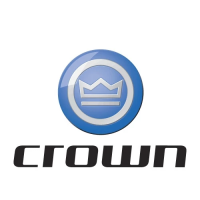
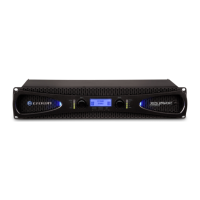

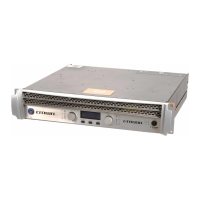


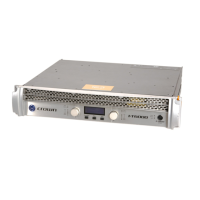
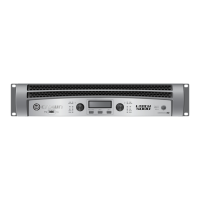

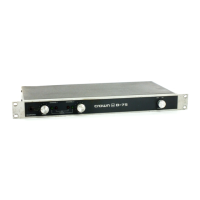


